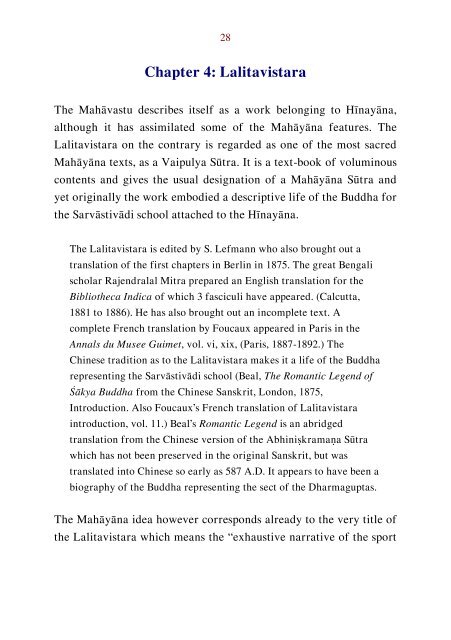Literary History of Sanskrit Buddhism
A study by J. K. Nariman of Sanskrit Buddhism from the Early Buddhist Tradition up to the Mahayana texts proper.
A study by J. K. Nariman of Sanskrit Buddhism from the Early Buddhist Tradition up to the Mahayana texts proper.
Create successful ePaper yourself
Turn your PDF publications into a flip-book with our unique Google optimized e-Paper software.
28<br />
Chapter 4: Lalitavistara<br />
The Mahāvastu describes itself as a work belonging to Hīnayāna,<br />
although it has assimilated some <strong>of</strong> the Mahāyāna features. The<br />
Lalitavistara on the contrary is regarded as one <strong>of</strong> the most sacred<br />
Mahāyāna texts, as a Vaipulya Sūtra. It is a text-book <strong>of</strong> voluminous<br />
contents and gives the usual designation <strong>of</strong> a Mahāyāna Sūtra and<br />
yet originally the work embodied a descriptive life <strong>of</strong> the Buddha for<br />
the Sarvāstivādi school attached to the Hīnayāna.<br />
The Lalitavistara is edited by S. Lefmann who also brought out a<br />
translation <strong>of</strong> the first chapters in Berlin in 1875. The great Bengali<br />
scholar Rajendralal Mitra prepared an English translation for the<br />
Bibliotheca Indica <strong>of</strong> which 3 fasciculi have appeared. (Calcutta,<br />
1881 to 1886). He has also brought out an incomplete text. A<br />
complete French translation by Foucaux appeared in Paris in the<br />
Annals du Musee Guimet, vol. vi, xix, (Paris, 1887-1892.) The<br />
Chinese tradition as to the Lalitavistara makes it a life <strong>of</strong> the Buddha<br />
representing the Sarvāstivādi school (Beal, The Romantic Legend <strong>of</strong><br />
Śākya Buddha from the Chinese <strong>Sanskrit</strong>, London, 1875,<br />
Introduction. Also Foucaux’s French translation <strong>of</strong> Lalitavistara<br />
introduction, vol. 11.) Beal’s Romantic Legend is an abridged<br />
translation from the Chinese version <strong>of</strong> the Abhiniṣkramaṇa Sūtra<br />
which has not been preserved in the original <strong>Sanskrit</strong>, but was<br />
translated into Chinese so early as 587 A.D. It appears to have been a<br />
biography <strong>of</strong> the Buddha representing the sect <strong>of</strong> the Dharmaguptas.<br />
The Mahāyāna idea however corresponds already to the very title <strong>of</strong><br />
the Lalitavistara which means the “exhaustive narrative <strong>of</strong> the sport


















